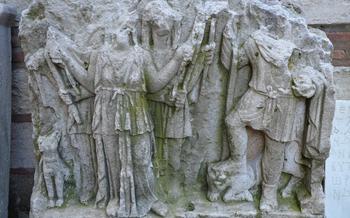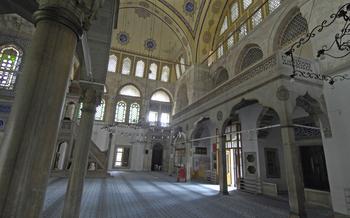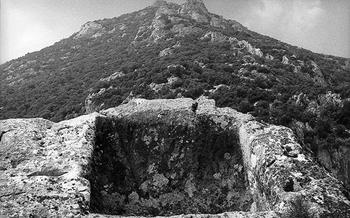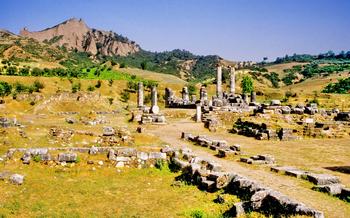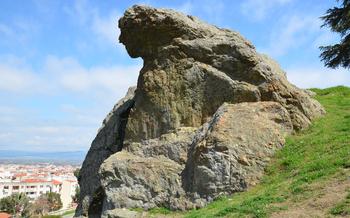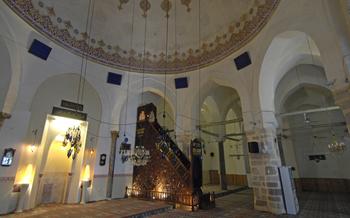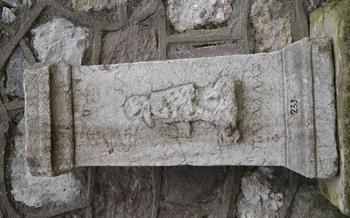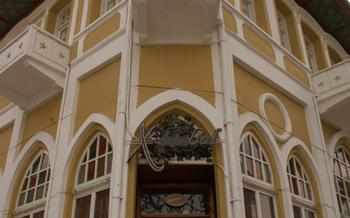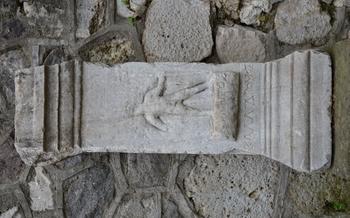
Tantalos Tomb
- Historical Significance
- Location and Accessibility
- Architectural Features
- Interior Exploration
- Mythology and Folklore
- Excavations and Discoveries
- Cultural Importance
- Visitor Experience
- Nearby Attractions
- Photography Opportunities:
- Local Cuisine
- Accommodation Options:
- Shopping and Souvenirs
- Safety and Security:
- Insider Tip:
Historical Significance
The Tantalos Tomb stands as a testament to the rich history and cultural heritage of Turkey. Its significance lies in its association with the legendary figure of Tantalos, a character from Greek mythology who was punished by the gods to stand in a pool of water beneath a fruit tree. Despite being surrounded by water and food, he was unable to quench his thirst or hunger, symbolizing his eternal torment. The tomb is believed to be the final resting place of Tantalos and serves as a reminder of the transience of human desires and the consequences of divine retribution. Additionally, the tomb's well-preserved state and unique architectural features make it an important archaeological site, shedding light on ancient burial practices and construction techniques.
Location and Accessibility
The Tantalos Tomb is situated in the province of Manisa, in western Turkey. It lies approximately 7 kilometers northeast of the city of Manisa, nestled amidst the foothills of the majestic Spil Mountain range. To reach this ancient relic from major cities like Istanbul or Ankara, visitors can take advantage of the well-connected transportation network in Turkey. From Istanbul, one can board a high-speed train to Manisa, which takes about 4 hours. Alternatively, domestic flights from Ankara to Manisa Airport offer a quicker option, with a flight time of approximately 1 hour. Upon arrival in Manisa, local buses or taxis can be easily arranged to take visitors to the Tantalos Tomb, making it readily accessible to travelers from all corners of Turkey.
Architectural Features
The Tantalos Tomb stands as a testament to the architectural prowess of the ancient Greeks. Constructed in the 4th century BC, the tomb features a unique and striking design that sets it apart from other tombs in the region. The exterior of the tomb is characterized by its massive stone blocks, which have been carefully fitted together without the use of mortar. The entrance to the tomb is flanked by two large columns, which support a triangular pediment. The pediment is adorned with intricate carvings depicting scenes from Greek mythology.
The interior of the tomb is equally impressive. The main chamber is a large, rectangular room with a high ceiling. The walls of the chamber are lined with niches, which were once used to store the remains of the deceased. The floor of the chamber is covered with a mosaic depicting a hunting scene. The mosaic is made up of thousands of small tiles, which have been arranged to create a vibrant and colorful image.
The Tantalos Tomb is a remarkable example of ancient Greek architecture. Its unique design and well-preserved state make it a must-visit for anyone interested in history and archaeology.
Interior Exploration
The Tantalos Tomb's interior is a fascinating and awe-inspiring sight, revealing the ingenuity and craftsmanship of ancient builders. The tomb consists of a series of chambers and corridors, each with its unique features. The main chamber, where Tantalos is believed to have been buried, is adorned with intricate carvings and murals depicting scenes from Greek mythology. Visitors can admire the well-preserved frescoes that tell stories of gods, heroes, and mythical creatures.
One of the most striking features of the tomb is the large stone sarcophagus, which is believed to have held Tantalos' remains. The sarcophagus is intricately carved with reliefs depicting various scenes, including Tantalos' torment in the underworld. Another notable feature is the "Treasury of Atreus," a smaller chamber located behind the main chamber. This chamber is known for its impressive corbelled dome, which is considered a marvel of ancient engineering.
As you explore the tomb, you can't help but feel a sense of wonder and awe at the sheer scale and grandeur of the structure. The darkness of the tomb adds to its mystique, creating an atmosphere of mystery and intrigue. The silence is broken only by the echoes of your footsteps and the occasional dripping of water from the walls.
While exploring the tomb's interior, be sure to take your time to observe the intricate details and carvings that adorn the walls and ceilings. Each symbol, each motif, and each scene holds a story, waiting to be deciphered and understood. The Tantalos Tomb is not just a historical site; it's a treasure trove of ancient knowledge and artistry, waiting to be discovered by curious and adventurous souls.
Mythology and Folklore
The Tantalos Tomb is steeped in ancient myths and folklore, with its origins deeply rooted in Greek mythology. Tantalos, a legendary figure from Greek mythology, was known for his hubris and was punished by the gods to stand in a pool of water beneath a fruit tree. Despite the water and fruit being close, he was unable to drink or eat as they receded whenever he tried. This tale of eternal torment has captured the imagination of storytellers and historians for centuries, adding to the allure of the Tantalos Tomb.
Local legends and traditions further enrich the mystique surrounding the tomb. One story tells of a hidden treasure buried beneath the tomb, guarded by spirits who protect the ancient secrets. According to another legend, the tomb holds the key to a lost city, waiting to be discovered by those who are worthy. These stories have been passed down through generations, weaving a tapestry of mystery and enchantment around the Tantalos Tomb.
Excavations and Discoveries
The Tantalos Tomb has been the subject of numerous archaeological excavations and studies throughout the years. The earliest excavations were conducted in the early 19th century by European explorers, who were fascinated by the tomb's unique architecture and its connection to Greek mythology. In the late 19th and early 20th centuries, more systematic excavations were carried out by Turkish archaeologists, who uncovered valuable artifacts and inscriptions that shed light on the tomb's history and significance.
One of the most significant discoveries at the Tantalos Tomb was the Tantalos Stele, a large stone tablet inscribed with a Greek text that provides a detailed account of the legend of Tantalos and his punishment in the underworld. This stele is considered a priceless artifact and is now housed in the Manisa Archaeological Museum.
Recent excavations at the tomb have focused on uncovering more information about its construction and use. Archaeologists have discovered evidence suggesting that the tomb was built in the 6th century BC and was originally used as a burial chamber for a wealthy Lydian family. Later, the tomb was repurposed as a temple and was used for religious rituals and ceremonies.
Ongoing research and studies at the Tantalos Tomb are aimed at understanding the tomb's architectural features, its relationship to other ancient sites in the region, and its role in the cultural and religious life of the ancient Lydians.
Cultural Importance
The Tantalos Tomb holds immense cultural significance in Turkey. It serves as a tangible link to the country's rich historical past and cultural heritage. The tomb's association with the legendary figure of Tantalos and its connection to Greek mythology further enhances its cultural value. Locals take pride in preserving and showcasing this ancient monument, which reflects their deep-rooted connection to their cultural heritage. The tomb's enduring presence has shaped local identity and fostered a sense of cultural continuity among the people of Manisa. Cultural events and festivals centered around the tomb celebrate its significance and provide opportunities for locals to share their traditions and folklore with visitors, fostering a sense of community and cultural exchange.
Visitor Experience
Stepping into the Tantalos Tomb is a journey through time that transports you back to an era of ancient myths and legends. The atmosphere is one of awe and wonder, as you stand surrounded by centuries-old stone walls that have witnessed countless stories unfold. The air is cool and still, with a faint echo of the past lingering within the tomb's chambers. As you explore the tomb's interior, let your imagination wander and envision the life and times of Tantalos, the legendary figure whose name is forever etched into the history of this place.
Practical Tips for Visitors:
- Best Time to Visit: The best time to visit the Tantalos Tomb is during the spring or autumn months, when the weather is pleasant and the crowds are smaller.
- What to Bring: Be sure to bring comfortable shoes for walking, as the tomb's terrain can be uneven. Also, bring a flashlight or headlamp to help illuminate the interior of the tomb.
- Guided Tours: Guided tours of the Tantalos Tomb are available, providing valuable insights into the tomb's history and significance.
Nearby Attractions
Beyond the Tantalos Tomb, Manisa offers a wealth of other captivating attractions. Immerse yourself in the rich history of the region at the Manisa Museum, showcasing an impressive collection of archaeological artifacts and exhibits. Marvel at the architectural grandeur of the Sultan Complex, a stunning ensemble of mosques, tombs, and madrasas dating back to the 15th century. Discover the beauty of nature at Spil Mountain National Park, boasting lush forests, cascading waterfalls, and breathtaking panoramic views. Indulge in the local flavors at the Manisa Food Festival, a vibrant celebration of traditional Turkish cuisine and culinary delights. For a unique shopping experience, explore the vibrant Manisa Bazaar, where you can find an array of handmade crafts, souvenirs, and local delicacies.
Photography Opportunities:
The Tantalos Tomb and its surroundings offer a wealth of picturesque scenery and photogenic spots for photography enthusiasts. Capture the grandeur of the ancient tomb against the backdrop of the rolling hills and lush greenery. Experiment with different angles and perspectives to showcase the architectural details and unique features of the site. Don't miss the opportunity to capture the tomb's interior, with its well-preserved frescoes and artifacts. Remember to be respectful of the site's historical significance and follow any photography guidelines or restrictions that may be in place.
Local Cuisine
When visiting the Tantalos Tomb and exploring Manisa, be sure to tantalize your taste buds with the region's delectable cuisine. Manisa offers a rich culinary experience that blends traditional Turkish flavors with local ingredients. One must-try dish is "Manisa Kebabı," a succulent lamb kebab marinated in yogurt and spices, grilled to perfection and served with fresh vegetables and crispy bread. Another local specialty is "Manisa Mantısı," delicate dumplings filled with minced meat and topped with a garlic-yogurt sauce.
For a sweet treat, indulge in "Manisa Mesir Macunu," a unique confection made from 41 different spices and herbs, believed to have medicinal properties and a delightful taste. Pair your meals with a glass of local wine from Manisa's vineyards, known for producing high-quality grapes. The local food culture emphasizes fresh, seasonal ingredients and generous hospitality. Embrace the opportunity to savor the culinary delights of Manisa, whether at traditional restaurants, charming cafes, or bustling markets.
Accommodation Options:
Manisa offers a range of accommodation options for visitors planning an overnight stay, catering to different budgets and preferences. For a luxurious experience, consider the Manisa Celal Bayar Hotel, renowned for its elegant rooms, spa facilities, and stunning views of the city. Alternatively, the Manisa Ramada Hotel provides a more affordable yet comfortable option, with modern amenities and a convenient location near the city center.
If you seek a unique and immersive stay, traditional Turkish guesthouses, known as "pansiyons," offer a glimpse into local culture. These guesthouses often feature charming historical buildings, cozy rooms, and authentic Turkish hospitality. For budget-conscious travelers, hostels and budget hotels provide a cost-effective option without compromising on comfort and cleanliness.
Before booking your accommodation, consider the proximity to the Tantalos Tomb and other attractions you plan to visit. Manisa is a relatively compact city, making it easy to get around on foot or by public transportation. Online booking platforms and travel agencies can assist you in finding the best deals and availability.
Shopping and Souvenirs
Manisa offers a delightful shopping experience for visitors who seek authentic souvenirs and local crafts. The city is renowned for its traditional Turkish handicrafts, including handwoven carpets, intricate pottery, and exquisite jewelry.
In the charming old town, visitors can explore the vibrant bazaars and shops that line the narrow cobbled streets. Here, they can find a treasure trove of souvenirs to remember their visit to Manisa and the Tantalos Tomb.
One of the must-buy items is the famous Manisa mesir paste, a traditional Turkish delight made from a blend of spices, nuts, and honey. This sweet treat is believed to have medicinal properties and is a popular gift to bring back home.
For those who appreciate handmade crafts, the local artisans create beautiful pottery, often adorned with intricate patterns and vibrant colors. Visitors can find unique pieces that showcase the region's rich artistic heritage.
Bargaining is a common practice in Turkish markets, and visitors can enjoy the experience of haggling with the friendly shopkeepers to get the best deals. It's important to be respectful and patient during negotiations, as it's seen as a way to build rapport and show appreciation for the local culture.
Safety and Security:
Manisa is generally considered a safe and welcoming city for tourists. However, as with any travel destination, it's essential to exercise caution and take necessary precautions to ensure your safety. When visiting the Tantalos Tomb and the surrounding area, be aware of your surroundings and keep an eye on your belongings. Avoid carrying large amounts of cash or valuables, and be wary of pickpockets in crowded areas. It's advisable to dress respectfully, covering your shoulders and knees when visiting religious or historical sites. In case of an emergency, you can dial 112 to reach the police, ambulance, or fire department.
Insider Tip:
Venture beyond the Tantalos Tomb to discover the hidden gem of the Sipylus Mountain National Park. Located just a short drive away, this breathtaking natural reserve offers stunning panoramic views, lush forests, and a diverse range of hiking trails. Immerse yourself in the tranquility of nature and explore ancient ruins, cascading waterfalls, and picturesque picnic spots. Don't miss the chance to witness the awe-inspiring sunset from the mountain's peak, a truly unforgettable experience that will leave you spellbound.
